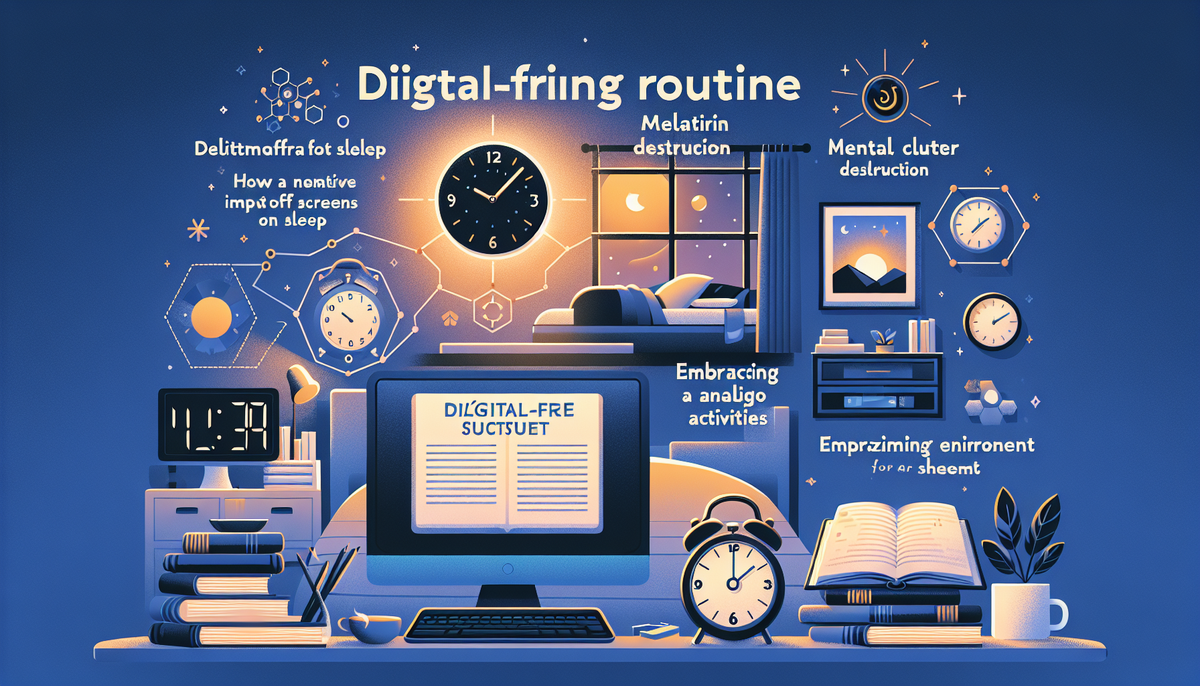Building a Digital-Free Evening Routine

Why a Digital-Free Evening is a Game-Changer for Your Health
In our hyper-connected world, the glow of screens has become a constant presence, often following us right into our bedrooms. While seemingly harmless, this habit of late-night scrolling, emailing, and streaming is a primary disruptor of our natural sleep-wake cycle, leading to what experts call poor sleep hygiene. The science is clear: creating a strict digital-free period before bed isn't just a trendy wellness tip; it's a fundamental pillar of physical and mental health. By reclaiming your evenings from the blue light of devices, you can significantly improve your sleep quality, reduce stress, and enhance your overall well-being. This guide will walk you through the essential steps to build a digital-free evening routine that sticks.
The Science of Blue Light and Sleep
The primary antagonist in our nighttime screen use is blue light. This specific wavelength of light is particularly effective at inhibiting the production of melatonin, the hormone responsible for regulating sleep. Your brain interprets the blue light from your phone, tablet, or laptop as daylight, tricking it into a state of wakefulness and alertness. This hormonal suppression makes it harder to fall asleep and reduces the quality of the sleep you do get, leaving you feeling groggy and unrested in the morning. A digital-free evening allows your body's natural melatonin production to proceed unhindered, paving the way for a quicker and deeper sleep.
Reducing Mental Clutter for a Peaceful Night
Beyond the physiological effects of blue light, evening screen time keeps your mind in a state of high alert. Engaging with social media, news articles, or work emails stimulates your brain, leading to mental clutter and even anxiety right at the time when you should be winding down. This constant stream of information prevents your mind from transitioning into a restful state. By swapping screen time for calming, analog activities, you create a buffer zone for your brain to process the day's events and settle into a state of tranquility, which is essential for restorative sleep.
Step 1: Planning Your 'Digital Sunset'
The first and most crucial step in creating your digital-free evening is to establish a clear and consistent cutoff time for all electronic devices. This concept, often called a "digital sunset," acts as a firm boundary between your connected day and your restful night. The goal is to create a non-negotiable rule that becomes an automatic part of your daily rhythm, signaling to your brain and body that the time for sleep is approaching.
Choosing Your "Off" Time
To start, aim for at least 60-90 minutes of screen-free time before your intended bedtime. If your goal is to be asleep by 10:30 PM, your digital sunset should be no later than 9:00 PM. Be realistic and start with a goal you can achieve. You can always increase the duration as the habit becomes more ingrained. Set a recurring alarm on your phone labeled "Digital Sunset" or "Time to Unplug" to help you stick to this new routine. Consistency is more important than perfection in the beginning.
Creating a Tech-Free Zone
Your bedroom should be a sanctuary for sleep, not a hub for digital entertainment. Make a firm rule: no screens in the bedroom. This means charging your phone, tablet, and laptop in another room overnight, such as the kitchen or living room. This physical separation is incredibly powerful. It removes the temptation to "just check one more thing" from your bed, which can easily turn into an hour of lost sleep. To replace your phone's alarm clock function, invest in an inexpensive, old-fashioned alarm clock.
Informing Your Friends and Family
Set expectations with the people in your life. Let your friends, family, and even colleagues know that you will be unreachable on digital channels after a certain time each evening. A simple message like, "Just to let you know, I'm trying to improve my sleep hygiene, so I'll be offline after 9 PM," is sufficient. This not only holds you accountable but also prevents you from feeling anxious about missing something important, as people will know when to expect a response.
Step 2: Rediscovering Analog Activities
Once you've powered down your devices, you'll be faced with a block of time that needs to be filled. This is not a void to be dreaded, but an opportunity to reconnect with yourself and the physical world. The key is to replace passive screen consumption with intentional, calming activities that you genuinely enjoy. Think of it as a chance to rediscover old hobbies or cultivate new ones that nourish your mind and soul.
Mindful Relaxation Techniques
Your newfound screen-free time is perfect for practices that calm the nervous system. Gentle stretching or yoga can release physical tension stored in the body after a long day. Meditation or simple deep-breathing exercises can quiet a racing mind, helping to lower your heart rate and blood pressure. Journaling is another powerful tool; writing down your thoughts, worries, or things you're grateful for can provide a sense of closure to the day and clear your mental slate before sleep.
Engaging Hobbies for a Calm Mind
Turn to hobbies that require focus and use of your hands. Reading a physical book (not on a backlit device) is a classic and effective way to unwind. Consider activities like knitting, sketching, or working on a puzzle. Listening to calming music, an engaging podcast, or an audiobook can also be a wonderful way to relax without looking at a screen. The goal is to choose something that you find immersive and enjoyable, that doesn't involve the stimulating glow of a digital display.
Preparing for a Successful Tomorrow
Use this quiet time to set yourself up for a smoother, less stressful morning. This productive form of "winding down" can be incredibly calming. Lay out your clothes for the next day, pack your gym bag, or prepare your lunch. Tidying up your living space for 10-15 minutes can also create a sense of order and calm. These simple acts of preparation reduce morning decision fatigue and contribute to a more peaceful state of mind as you head to bed.
Step 3: Optimizing Your Environment for Sleep
The final piece of the puzzle is to ensure your physical environment is perfectly calibrated for deep, uninterrupted sleep. Your bedroom's atmosphere has a profound impact on your sleep quality. By making a few simple adjustments, you can transform your bedroom into a true sleep sanctuary that complements your new, screen-free evening habits and enhances your sleep hygiene.
The Importance of a Dark, Cool Room
Your body sleeps best in a cool, dark, and quiet environment. Invest in blackout curtains or a comfortable eye mask to block out all sources of light, which can disrupt melatonin production even in small amounts. The ideal room temperature for sleep is generally between 60 and 67 degrees Fahrenheit (15-19 degrees Celsius). A cooler room helps to lower your body's core temperature, which is a natural trigger for sleep.
Soothing Scents and Sounds
Engage your other senses to promote relaxation. Use an essential oil diffuser with calming scents like lavender, chamomile, or sandalwood. If you live in a noisy area, consider using a white noise machine or a fan to block out disruptive sounds. The consistent, gentle hum can help mask sudden noises that might otherwise wake you up, creating a stable and peaceful auditory environment.
The Power of a Warm Bath or Shower
One of the most effective sleep-inducing rituals is taking a warm bath or shower about 90 minutes before bed. The warm water helps to relax your muscles and calm your mind. More importantly, the subsequent drop in your body temperature after you get out mimics the natural temperature drop that occurs before sleep, sending a powerful signal to your brain that it's time to rest. This simple act can significantly decrease the time it takes you to fall asleep.
Conclusion: Your Journey to Better Rest
Building a digital-free evening routine is a profound act of self-care. It's about consciously deciding to prioritize your health and well-being over the endless demands of the digital world. By implementing a 'digital sunset,' rediscovering calming analog activities, and optimizing your sleep environment, you are not just improving your sleep hygiene; you are creating a more balanced and peaceful life. Start your journey tonight. Choose one or two small changes from this guide and commit to them. Your mind and body will thank you for it.


